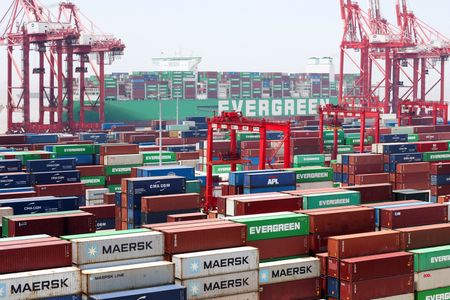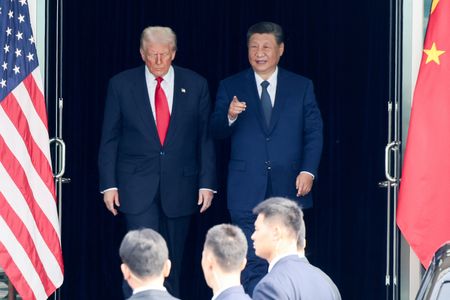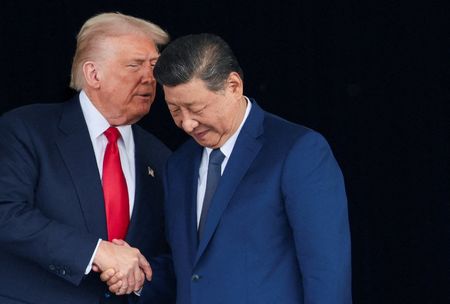(Corrects closing soybean futures price in paragraph 7 to $11.07-3/4 per bushel from $11.06)
By David Lawder, Maiya Keidan and Karl Plume
CHICAGO (Reuters) -U.S. Treasury Secretary Scott Bessent said on Thursday that China has agreed to buy 12 million metric tons of American soybeans during the current season through January, down from 22.5 million tons in the prior season after a months-long tariff battle halted all purchases of the current U.S. harvest.
China also committed to buying 25 million tons annually for the next three years as part of a larger trade agreement with Beijing, Bessent said.
The drop in Chinese demand cost U.S. farmers – a key pillar of President Donald Trump’s political base – billions of dollars in lost sales and the deal would represent a return to normalcy in trade with the top U.S. soy importer, which averaged purchases of 28.8 million tons over the past five September-to-August crop seasons.
“So our great soybean farmers, who the Chinese used as political pawns – that’s off the table, and they should prosper in the years to come,” Bessent told Fox Business Network’s “Mornings with Maria” program.
The agreement negotiated in Malaysia over the weekend could be signed as soon as next week, he said.
Bessent said other countries in Southeast Asia have agreed to buy another 19 million tons of U.S. soybeans, but did not specify a timeframe for those purchases or the nations involved. Asian importers other than China have imported between 8 million and 10 million tons annually in recent years, according to U.S. Census Bureau trade data.
The most-active soybean contract on the Chicago Board of Trade reversed earlier losses and closed 1.2% higher at a 15-month high of $11.07-3/4 per bushel. [GRA/]
“These (Chinese purchase agreements) are not numbers that are unattainable, but they’re also not numbers that are really supporting the idea of expansion for our U.S. soybean export program,” said Ted Seifried, chief market strategist for Zaner Ag Hedge.
RELIEF IN THE U.S. FARM BELT
U.S. farm groups cheered the agreements after Trump’s bruising trade war eroded soy exports valued at $24.5 billion last year. Growers have nearly finished harvesting what is expected to be the fifth-largest U.S. crop on record.
The lack of Chinese demand has squeezed U.S. farm incomes as crop prices hovered near multi-year lows for months amid rising costs for fertilizer, seeds, labour and equipment.
“This is a meaningful step forward to reestablishing a stable, long-term trading relationship that delivers results for farm families and future generations,” said American Soybean Association President and Kentucky farmer Caleb Ragland.
The agreement with China came after Trump secured agricultural trade deals or framework agreements with other Asian nations.
“Expanding markets and restoring purchases by China will provide some certainty for farmers who are struggling just to hold on,” said American Farm Bureau Federation President Zippy Duvall.
CHINA DIVERSIFYING SOYBEAN PURCHASES
Trump wrote in a social media post overnight after a meeting with Xi Jinping in South Korea that the Chinese leader had authorized China to begin the purchase of massive amounts of soybeans, sorghum and other farm products.
U.S. Agriculture Secretary Brooke Rollins applauded Trump’s comments on soybeans and sorghum in a post on X.
But Even Rogers Pay, director at Beijing-based Trivium China, said the agreement effectively constituted a return to business as usual in terms of U.S. soybean exports to China.
“It targets a level of trade that has been pretty consistent with the past few years,” she said.
Johnny Xiang, founder of Beijing-based AgRadar Consulting, said commercial buyers were still awaiting details such as whether China would reduce the tariff on U.S. soybeans from 20% to 10%, or remove it entirely.
“If the tariff is not completely lifted, commercial buyers will have little incentive to purchase U.S. soybeans,” he said.
China, the world’s biggest soybean buyer and the top market for U.S. farmers, had turned its vast appetite for U.S. crops into a powerful trade war bargaining chip.
Facing import duties of 23% on soybeans after rounds of tit-for-tat tariffs, Chinese buyers largely shunned the U.S. autumn harvest, turning instead to South American supplies.
Since the trade war of the first Trump administration, China has diversified its sources of soybean imports. In 2024, China bought roughly 20% of its soybeans from the United States, down from 41% in 2016, customs data shows.
(Reporting by David Lawder and Karl Plume in Chicago; Andrea Shalal, Daniel Burns and Leah Douglas in Washington, Maiya Keidan in Toronto and Ella Cao in BeijingEditing by Doina Chiacu, Mark Potter, Andrea Ricci and Nia Williams)










